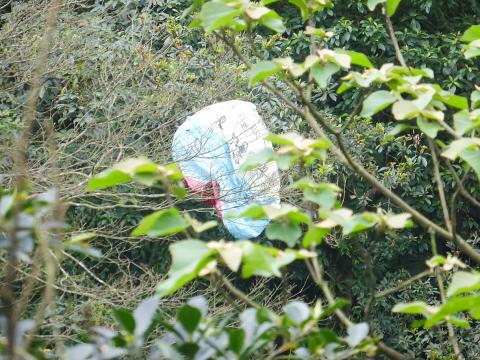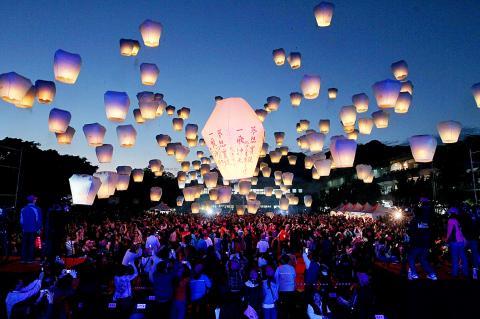A photo of a dead owl tangled in a sky lantern has resurfaced on the Internet in recent years every time the Lunar New Year approaches. Even though the photo is neither recent nor was it taken in Taiwan, it’s still one of the more visible symbols surrounding the debate that ignites every year surrounding the Pingsi Sky Lantern Festival.
Watching hundreds of brightly-colored sky lanterns rise from the crowd, blanket the sky and disappear into the night is probably one of the more spectacular sights you can see in Taiwan, and the festival has been gaining global recognition, being frequently named as a must-travel destination in various prestigious publications.
“Pingsi’s sky lanterns have transformed from a local folk activity into an internationally important festival,” Eric Chu (朱立倫), New Taipei City mayor said last year.

Photo: Lin Hsin-han, Taipei Times
But the lanterns surely don’t just disappear into the sky. There’s no denying the festival’s cultural value and economic impact, but many citizens have been calling to boycott the event due to its impact on the ecosystem as the lanterns fall and scatter in the wilderness and possibly onto residences.
The arguments are similar each year: It’s a fire hazard, it creates litter, the kerosene pollutes the soil and rivers while animals may accidentally ingest the debris along with its metal wires or become tangled, like the owl in the photo.
BANNED LANTERNS

Photo courtesy of the New Taipei City Government’s Tourism and Travel Department
Almost all counties and cities in Taiwan have banned the use of sky lanterns — but, like Tainan’s ordinance, for example, some exceptions are allowed during traditional events. The designated area in Pingsi Township, New Taipei City, is the only place where it’s legal to set off lanterns year round from 6am to 10pm.
This year the debate was ignited by several Internet posts, including one by animal rights organization Wuo Wuo (窩窩), which, incidentally, used the photo of the dead owl. The post states that in the old days, the lanterns weren’t as big as they are now and were constructed with biodegradable bamboo and paper. Today, to save money and time, they are often made with metal wire and even plastic components.
An unlikely proponent for boycotting the festival was technology entrepreneur Ben Jai (翟本喬), who posted on his Facebook that if people wanted to set off sky lanterns they should unfriend him first.
A wave of comments followed, with some supporting him and others disagreeing, including one Pingsi resident who claims that her family was able to make a living off of the sky lanterns.
Another post that went viral was a video, A Truth We’re Unwilling to Face (不願面對的真相), filmed on Jan. 1 by avid biker Eddie Chen (陳忠利), who often visits the area. It shows sky lanterns falling into the green mountains
“Look closely, the white dots in the mountains are not flowers, they’re the garbage produced after you make your wish,” a caption reads.
Much of the discussion around Chen’s video centered on the fact that even though the festival only takes place over the course of a few weeks once per year, people are still allowed to set off lanterns in Pingsi every day as opposed to other cultural events such as the Yenshui Beehive Fireworks Festival in Tainan. They claim that it’s no longer a traditional activity and has become a means of profit.
Huang Jui-fen (黃瑞芬), a concerned citizen who says she has done extensive research on the issue, recently wrote a letter to the New Taipei City government urging them to stop organizing the festival and ban all uses of sky lanterns. She says that the lantern festival was never a tradition — people used them in the late 1800s for communication purposes and the festivities didn’t begin until the 1990s.
“They were never used for wishing good luck and were never released on such a massive scale,” she says. “This is businessmen and the government working together to make money in the name of tradition. It’s a public hazard and the government is the one leading the public in doing such a thing.”
Huang received a rather generic reply from the government, more concise but similar than what they sent the Taipei Times below.
GOVERNMENT RESPONSE
New Taipei City’s tourism and travel department provided the Taipei Times with sky lantern regulations — which do not mention what material the lanterns should be made of, though it specifies the amount of fuel (kerosene-soaked paper) each lantern is allowed to contain so they don’t fly too high or far.
The standard modern design, detailed in a 2009 paper from Chaoyang University of Technology as well as other sources, show that metal wires are an essential component.
The department states that surrounded by mountains on all sides, Pingsi’s landscape provides a natural barrier for the lanterns, which can rise up to between 600m and 800m and travel within a 5km radius, so they remain and fall in the area, making it “very safe.” This does not address the lanterns’ impact on Pingsi itself, which is what public concern appears to be about.
The city has also implemented a recycling program, where residents can turn in lantern frames and paper for money, giving them incentive to help with the cleaning effort. However, the 31,890 lantern papers recycled in 2015 are just a fraction of the total amount of lanterns set off per year — estimates vary between 300,000 and 600,000.
After receiving almost identical information from the tourism department, Jai changed his stance and posted that he is no longer against sky lanterns and even issued a public apology.
This set off another wave of mostly angry comments, with people pointing out the government’s faulty logic and claiming that cleanup efforts are far from adequate and that sky lanterns can still be seen all over the mountains. One Pingsi resident posted that his roof was lit on fire once.
Meanwhile, the lantern festival seems to get bigger and more elaborate each year with more and more tourists arriving due to international promotion — and there doesn’t seem to be any resolution to the debate any time soon.

This is the year that the demographic crisis will begin to impact people’s lives. This will create pressures on treatment and hiring of foreigners. Regardless of whatever technological breakthroughs happen, the real value will come from digesting and productively applying existing technologies in new and creative ways. INTRODUCING BASIC SERVICES BREAKDOWNS At some point soon, we will begin to witness a breakdown in basic services. Initially, it will be limited and sporadic, but the frequency and newsworthiness of the incidents will only continue to accelerate dramatically in the coming years. Here in central Taiwan, many basic services are severely understaffed, and

It is a soulful folk song, filled with feeling and history: A love-stricken young man tells God about his hopes and dreams of happiness. Generations of Uighurs, the Turkic ethnic minority in China’s Xinjiang region, have played it at parties and weddings. But today, if they download it, play it or share it online, they risk ending up in prison. Besh pede, a popular Uighur folk ballad, is among dozens of Uighur-language songs that have been deemed “problematic” by Xinjiang authorities, according to a recording of a meeting held by police and other local officials in the historic city of Kashgar in

Jan. 5 to Jan. 11 Of the more than 3,000km of sugar railway that once criss-crossed central and southern Taiwan, just 16.1km remain in operation today. By the time Dafydd Fell began photographing the network in earnest in 1994, it was already well past its heyday. The system had been significantly cut back, leaving behind abandoned stations, rusting rolling stock and crumbling facilities. This reduction continued during the five years of his documentation, adding urgency to his task. As passenger services had already ceased by then, Fell had to wait for the sugarcane harvest season each year, which typically ran from

The People’s Republic of China (PRC) was out in force in the Taiwan Strait this week, threatening Taiwan with live-fire exercises, aircraft incursions and tedious claims to ownership. The reaction to the PRC’s blockade and decapitation strike exercises offer numerous lessons, if only we are willing to be taught. Reading the commentary on PRC behavior is like reading Bible interpretation across a range of Christian denominations: the text is recast to mean what the interpreter wants it to mean. Many PRC believers contended that the drills, obviously scheduled in advance, were aimed at the recent arms offer to Taiwan by the